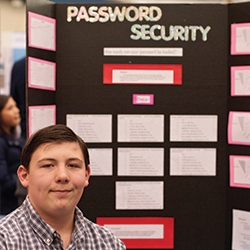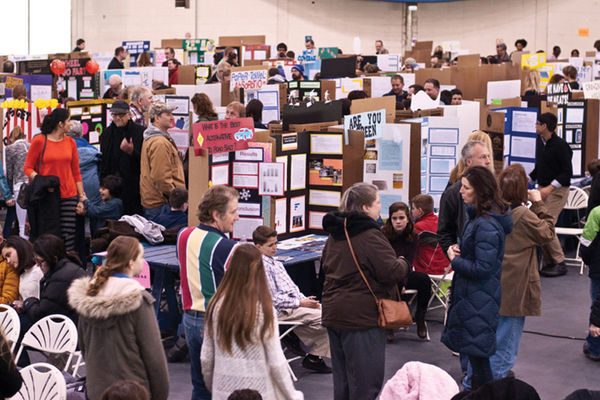
Tony Kramer and Sam Chippas, seniors at Marian High School, combined their interests in electrical engineering and computer science to develop a robotics project for the March 4 Northern Indiana Regional Science and Engineering Fair (NIREF) at Notre Dame.
The project included a self-designed motherboard that controls sensors and motors to move the robot– an upright structure with 3D-printed arms that can keep its balance and “learn” through artificial intelligence. Their system can be used in applications where humans could be sickened or injured, Chippas said.
The fair featured 260 projects with topics from ecology to computer science. Students in grades 3-12 from more than 40 schools in four northern Indiana counties competed in three age divisions for a variety of awards. Twenty projects – 10 from the elementary-junior divisions and 10 from the high school division – were chosen to represent northern Indiana in the 29th Annual Hoosier Science and Engineering Fair on April 1 at Indiana University-Purdue University in Indianapolis.

Science fairs are valuable for students of all ages because children are born with a natural curiosity about the world around them, said Micha Kilburn, executive director of the NIRSEF and assistant professional specialist in the University’s physics department.
“Science experiments can teach skills such as problem solving, math and logic skills, the ability to learn new technology, attention to detail, and creativity,” she said. “Presenting the experiment at a science fair also teaches communication skills.”
Sienna Thompson, a sixth-grade student at Veritas Academy, said that she learned about the scientific method of developing and testing a hypothesis while completing her project about the viscosity of different liquids.
But that was topped by being at the fair because “it was great and real fun because we got to look at everyone’s projects,” she said.
Winning the Notre Dame Mathematics Department Award for the junior division, Jared Reeves, an eighth-grade student at Mishawaka Catholic School, described how he created a computer program to decipher how long it takes to crack passwords of different lengths. His results showed that passwords of at least eight different characters (or more) are the hardest to hack.
Skills learned in creating science fair projects will transfer well to college and careers later, Kilburn said.
“We don’t know what jobs will exist in the future, just like we couldn’t have predicted many of today’s jobs 20 years ago. In fact, many of today’s science fair participants will go on to careers that don’t even exist yet.”
That may be true for Kramer and Chippas, whose hard work paid off – their project was among the 10 chosen in the senior division to move on to the state fair next month.
“This guides us toward our careers later on,” said Chippas of Plymouth, Ind., adding that he and Kramer plan to attend Purdue University in the fall.
Originally published by at science.nd.edu on March 09, 2017.